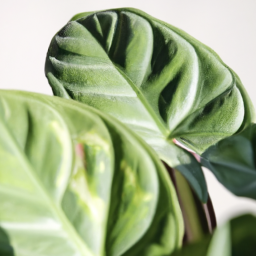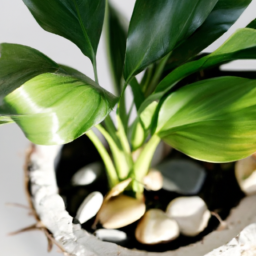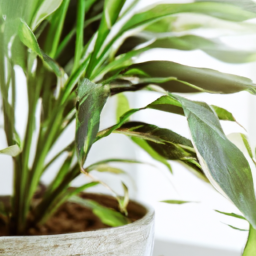
Are you looking for a simple and natural way to improve the air quality in your home? Look no further than indoor plants! Yes, you heard it right – indoor plants clean air. Not only do they add a touch of greenery and beauty to your living space, but they also act as natural air purifiers, removing harmful toxins and pollutants from the air we breathe. In this blog post, we will delve into the fascinating world of indoor plants and explore how they can effectively clean the air, making your home a healthier and more pleasant environment to live in. So, let’s dive in and discover the wonders of indoor plants and their ability to freshen up your indoor air!
The Benefits of Indoor Plants for Clean Air
Indoor plants not only add beauty and vibrancy to our homes and offices, but they also play a crucial role in improving the air quality we breathe. In recent years, the importance of indoor air quality has gained significant attention, as studies have shown that the air inside our buildings can be even more polluted than the air outside. This is due to various factors such as poor ventilation, the presence of harmful chemicals, and the accumulation of allergens.
Fortunately, certain indoor plants have the remarkable ability to filter out toxins from the air, releasing fresh oxygen and creating a healthier living environment. This natural air purification process, known as phytoremediation, not only helps to remove harmful pollutants but also enhances our overall well-being. Let’s delve into the numerous benefits of incorporating indoor plants for clean air in our homes and workplaces.
1. Improved Indoor Air Quality
Indoor air pollution can have a detrimental impact on our health, leading to various respiratory issues, allergies, and even long-term complications. However, by introducing indoor plants, we can significantly improve the quality of the air we breathe. Plants act as natural air filters, absorbing harmful gases and chemicals, while also releasing moisture that helps to increase humidity levels. This process not only reduces the concentration of pollutants but also helps to alleviate symptoms related to dry air, such as dry skin and irritated eyes.
Moreover, certain plants, such as the Snake Plant (Sansevieria), Spider Plant (Chlorophytum comosum), and Aloe Vera (Aloe barbadensis), have been proven to effectively remove common indoor pollutants like formaldehyde, benzene, and trichloroethylene. By strategically placing these plants in different rooms, we can create a healthier and more breathable environment for ourselves and our loved ones.
Additionally, indoor plants have been found to reduce airborne dust and mold spores, further contributing to improved air quality. The presence of plants in indoor spaces has been associated with a decreased risk of respiratory illnesses and allergies, making them an essential addition to any living or working area.
2. Enhanced Mental Well-being
Indoor plants not only have physical benefits but also play a significant role in promoting mental well-being. Numerous studies have shown that being surrounded by nature, even in the form of indoor plants, can have a positive impact on our mood, concentration, and overall mental health.
The presence of greenery indoors has been linked to reduced stress levels and improved productivity. Research has shown that individuals working or studying in environments with plants tend to experience lower levels of stress and fatigue, leading to increased focus and creativity. The calming effect of plants can also help to create a sense of tranquility and relaxation, making them particularly beneficial in high-stress environments like offices or study areas.
Furthermore, indoor plants can improve the quality of our sleep. Certain plants, such as Lavender (Lavandula angustifolia), Jasmine (Jasminum spp.), and Aloe Vera, release soothing scents that can promote better sleep and relaxation. Placing these plants in our bedrooms can create a more peaceful and restful atmosphere, allowing us to wake up feeling refreshed and rejuvenated.
3. Natural Humidifiers and Air Fresheners
Indoor air can often become dry, especially during the colder months when heating systems are in use. Dry air can lead to various discomforts, including dry skin, irritated nasal passages, and respiratory issues. However, indoor plants can act as natural humidifiers, releasing moisture into the air through a process known as transpiration.
Plants like Boston Fern (Nephrolepis exaltata), Areca Palm (Dypsis lutescens), and Peace Lily (Spathiphyllum wallisii) are particularly effective at increasing humidity levels and creating a more comfortable living environment. By placing these plants strategically throughout our homes, we can combat the negative effects of dry air and enjoy improved respiratory health.
Moreover, many indoor plants emit pleasant fragrances that can naturally freshen the air. Plants such as Geraniums (Pelargonium spp.), Gardenias (Gardenia spp.), and Mint (Mentha spp.) release aromatic compounds that can mask unpleasant odors and create a more inviting atmosphere. Instead of relying on artificial air fresheners, incorporating these fragrant plants into our indoor spaces provides a healthier and more sustainable alternative.
In conclusion, the benefits of indoor plants for clean air are undeniable. From improving indoor air quality and enhancing our mental well-being to acting as natural humidifiers and air fresheners, these green companions bring us numerous advantages. So, let’s embrace nature’s gift and fill our indoor spaces with a variety of plants to create a healthier and more harmonious environment for ourselves and our loved ones.

Top Indoor Plants That Purify the Air
When it comes to improving the air quality in your home or office, indoor plants are a natural and effective solution. Not only do they add a touch of greenery and beauty to your space, but they also act as natural air purifiers. These plants have the ability to remove harmful toxins from the air, making it cleaner and healthier for you to breathe. In this article, we will explore the top indoor plants that are known for their air-purifying properties.
1. Snake Plant (Sansevieria trifasciata)
The snake plant, also known as mother-in-law’s tongue, is a popular choice for indoor spaces due to its low maintenance requirements and air-purifying abilities. This plant is particularly effective at removing formaldehyde, a common indoor pollutant found in cleaning products, furniture, and carpets. Additionally, the snake plant releases oxygen at night, making it an ideal choice for bedrooms to promote better sleep.
To care for a snake plant, place it in a well-lit area, but it can tolerate low light conditions as well. Water the plant sparingly, allowing the soil to dry out between waterings. Snake plants are known for their resilience and can tolerate neglect, making them perfect for those who are new to indoor gardening.
Another benefit of the snake plant is its ability to absorb carbon dioxide and release oxygen, even in low light conditions. This makes it an excellent choice for improving air quality in rooms with limited natural light, such as basements or offices with few windows.
2. Peace Lily (Spathiphyllum)
The peace lily is not only a beautiful plant with its elegant white flowers, but it is also highly effective at removing common indoor pollutants like benzene and formaldehyde. This plant has been found to improve air quality by up to 60% within just a few days of being placed in a room.
Caring for a peace lily is relatively easy. It thrives in low to medium light conditions, making it suitable for rooms with limited sunlight. Keep the soil slightly moist and avoid overwatering, as this can lead to root rot. The peace lily will also let you know when it needs water, as its leaves will droop slightly.
One important thing to note about peace lilies is that they are toxic to pets if ingested. Therefore, it is essential to keep them out of reach of curious cats and dogs to ensure the safety of your furry friends.
3. Spider Plant (Chlorophytum comosum)
The spider plant is another popular choice for indoor gardening enthusiasts due to its air-purifying qualities and ability to thrive in various conditions. It is known for effectively removing formaldehyde, xylene, and toluene from the air, which are commonly found in household products and paints.
Caring for a spider plant is relatively easy, even for beginners. It prefers bright, indirect light but can tolerate lower light conditions. Water the plant when the top inch of soil feels dry, and avoid overwatering, as this can cause root rot. Spider plants also produce offsets, or “spiderettes,” which can be separated and planted to grow new plants.
In addition to its air-purifying benefits, the spider plant is also non-toxic to pets, making it a safe choice for households with furry friends.
These are just a few examples of indoor plants that can help improve the air quality in your home or office. By incorporating these plants into your indoor space, you can create a healthier environment and enjoy the many benefits that come with having living, breathing companions.

How to Maintain Indoor Plants for Optimal Air Quality
Welcome to our guide on maintaining indoor plants for optimal air quality! Indoor plants not only add beauty and greenery to your living space but also play a crucial role in purifying the air you breathe. In this article, we will provide you with a step-by-step guide on how to effectively care for your indoor plants to ensure they are thriving and contributing to cleaner air in your home or office.
Choosing the Right Indoor Plants
The first step in maintaining indoor plants for optimal air quality is selecting the right plants for your space. Different plants have varying abilities to filter and purify the air, so it’s essential to pick the ones that best suit your needs. Here are a few popular options:
1. Snake Plant (Sansevieria trifasciata): This plant is known for its ability to remove toxins such as formaldehyde and benzene from the air. It is a low-maintenance plant that thrives in low light conditions, making it perfect for beginners.
2. Peace Lily (Spathiphyllum): Peace lilies are excellent at removing airborne toxins like ammonia, benzene, and formaldehyde. They prefer medium to low light conditions and require regular watering.
3. Spider Plant (Chlorophytum comosum): Spider plants are effective in removing formaldehyde and xylene from the air. They are adaptable to various light conditions and are easy to care for.
Once you have chosen the right indoor plants, it’s time to focus on their maintenance to ensure optimal air quality in your space.
Providing Adequate Light and Water
Proper lighting and watering are essential for the health and well-being of your indoor plants. Here’s what you need to know:
Light: Most indoor plants thrive in bright, indirect light. Place them near windows or in areas where they can receive filtered sunlight. Avoid exposing them to direct sunlight, as it can scorch the leaves. If you have low light conditions, choose plants that can tolerate such environments, like snake plants or pothos.
Water: Each plant has different water requirements, so it’s crucial to understand the needs of your specific plants. Overwatering can lead to root rot, while underwatering can cause wilting and stunted growth. As a general rule, water your plants when the top inch of soil feels dry. Use room temperature water and ensure proper drainage to prevent waterlogging.
Regularly monitoring the light and water needs of your indoor plants will help them thrive and effectively purify the air in your home.
Fertilizing and Pruning
Aside from light and water, indoor plants also require proper nutrition and occasional pruning to maintain their optimal air-purifying abilities:
Fertilizing: Indoor plants benefit from regular fertilization to ensure they receive essential nutrients. Choose a balanced, water-soluble fertilizer and follow the instructions on the packaging. Over-fertilizing can lead to salt buildup in the soil, which can harm the plants.
Pruning: Pruning helps maintain the shape and size of your indoor plants while also promoting healthier growth. Remove any dead or yellowing leaves, as they can attract pests and hinder air circulation. Additionally, trimming overcrowded branches allows better airflow and prevents the plant from becoming leggy.
Regularly fertilizing and pruning your indoor plants will keep them in top condition, ensuring they continue to effectively clean the air in your space.
By following these steps, you can maintain indoor plants for optimal air quality. Remember to choose the right plants, provide adequate light and water, and regularly fertilize and prune them. With proper care, your indoor plants will not only enhance the aesthetics of your space but also contribute to a healthier and cleaner environment.
Let’s recap
Indoor plants not only add beauty and charm to our living spaces but also have the incredible ability to clean the air we breathe. Yes, you heard that right! These green wonders do more than just sit pretty on our windowsills; they actively work to purify the air by removing harmful toxins and releasing fresh oxygen. So, if you’re looking for a natural and cost-effective way to improve the air quality in your home or office, it’s time to bring in some leafy companions.
Numerous scientific studies have shown that indoor plants can effectively filter out common pollutants like formaldehyde, benzene, and trichloroethylene, which are often found in household items and cleaning products. These toxins can cause a range of health issues, including headaches, respiratory problems, and even more severe conditions in the long run. By introducing plants such as peace lilies, spider plants, or snake plants into your indoor environment, you can significantly reduce the concentration of these harmful substances, creating a healthier and more pleasant atmosphere for everyone. Plus, plants also help to increase humidity levels, reduce dust, and absorb noise, making them all-around champions when it comes to improving indoor air quality.
Q&A Corner:
Q1: How do indoor plants help clean the air?
A1: Indoor plants have the remarkable ability to naturally purify the air by absorbing harmful pollutants and releasing oxygen. Through a process called photosynthesis, plants take in carbon dioxide and other toxins from the air and convert them into oxygen, thus improving the air quality of your indoor space.
Q2: Which indoor plants are best for cleaning the air?
A2: Several indoor plants are known for their air-purifying qualities. Some popular choices include the Spider Plant, Peace Lily, Snake Plant, Aloe Vera, and English Ivy. These plants are effective in removing toxins like formaldehyde, benzene, and xylene from the air, helping to create a healthier environment.
Q3: How many indoor plants do I need to clean the air in my home?
A3: The number of indoor plants needed to effectively clean the air in your home depends on various factors such as the size of your space, the level of pollution, and the specific plants you choose. As a general guideline, it is recommended to have at least one medium-sized plant (6-8 inch pot) per 100 square feet of living space for noticeable air purification benefits.
Q4: Do indoor plants require special care to maintain their air-purifying properties?
A4: While indoor plants do require some care, maintaining their air-purifying properties is relatively easy. Regularly dusting the leaves of your plants with a damp cloth helps to keep their pores open for optimal air filtration. Additionally, providing adequate sunlight, water, and occasional fertilization will ensure that your indoor plants stay healthy and continue to clean the air effectively.
Q5: Can indoor plants improve my overall well-being, apart from cleaning the air?
A5: Absolutely! Indoor plants offer numerous benefits beyond air purification. They can enhance your mood, reduce stress levels, and improve concentration and productivity. Plants also add a touch of natural beauty to your indoor space, creating a more calming and inviting atmosphere. So, apart from cleaner air, indoor plants contribute to your overall well-being in multiple ways.

James Wong is a renowned ethnobotanist, plant scientist, and local television presenter. With a passion for demystifying plant science, he is known for translating complex botanical concepts into practical advice for everyday plant enthusiasts. James’s expertise spans from traditional gardening to cutting-edge plant technologies, making his insights accessible and informative.


